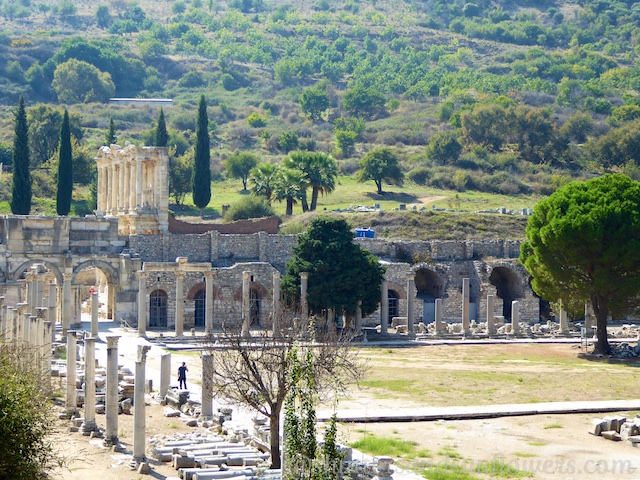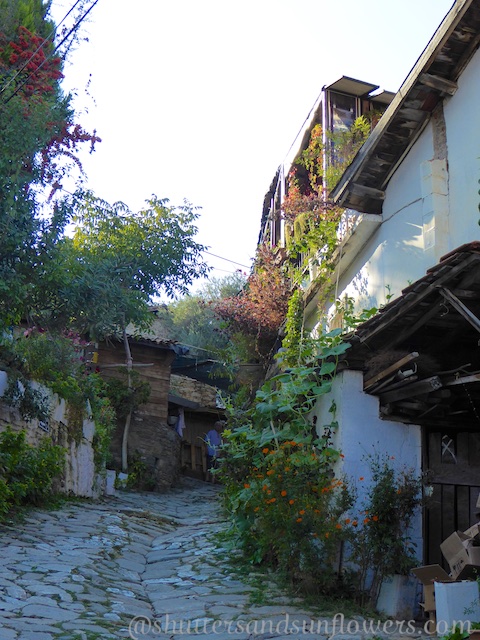Close your eyes, be quite still, concentrate hard and listen carefully……. Then conjure up the sounds of Ephesus, the clattering rumble of chariot wheels passing along the marble paved street just inches from your toes. The occasional crack of a whip and startled whimper of a horse.
Snatched snippets of conversations peppered with laughter or exclamation.
Small, questioning children’s voices, complaining of the heat, pleading to go home.
The background hum of people, going about their business in Ephesus, some frantically rushing to appointments, others just out meeting friends or shopping. Pedlars trading their wares, the frenzy of commerce.
The symphony of a city, then, the Roman city of Ephesus, really not so different from now……………..
Incredulous and full of excited wonder probably best describes how it feels as you enter Ephesus to walk along the same marble street where leather sandals trod thousands of years ago.
Curetes Street in Ephesus,
This was the main street in Ephesus, known as ‘Embolos’ in ancient times. Paved in marble it was 210 meters in length, and lined with prestigious porticoes with shops behind them and a sewer running beneath. Maintenance of this impressive street continued well into the 6th/7th centuries A.D. 
The Celsus Library of Ephesus
At the end of Curetes Street lies the stunning Celsus Library, often thought as the landmark of Ephesus. Built A.D. 114 -117 by Tiberius Julius Aquila, as a mausoleum for his father Tiberius Julius Celsus Polemaeanus, who was proconsul (governor) of the Asian province, the capital of which was Ephesus. Constructed from high quality marble, the two-storeyed facade has Corinthian columns capitals placed on the 21 meters long podium, reached by nine steps.

The ‘Tetragonos Agora’
A view over the ‘Agora’, the Commercial Market of Ephesus, a thriving business center from 294 B.C. You can imagine the bustling activity that took place here, the essence of city life which largely remains unchanged in cities today, just without the purring, screeching ‘tune’ of vehicles and mechanisation.

Across the passages of time only the weather is a constant, the unrelenting heat making you yearn for shade and a cooling fresh breeze, grateful that the stench of human kind and animals no longer pollutes the still and heavy air.
The Roman Latrina
The Romans actually did much to cope with sanitation, they were centuries a head of their time and in Ephesus built underground sewer systems and the Latrina, first century A.D. public toilets. The toilets were arranged side by side but with no partition between them! In the middle was a square pool, the floor was even paved with mosaics.

The Medical Centre ruins
In ancient times temples were used to gather the ill. Soranus, Rufus and Alexandros were famous Ephesian doctors, their written works being of great importance to medical history. During the Roman period, Ephesus was the home to a very large medical school. Bronze lancets used for bloodletting have been found here, also surgeon’s drills, needles, spatulas, curettes, hooks and mortars & pestles for mixing medicines; all now on display in the Ephesus Museum in Selcuk.

The Nike Swoosh
Outside the medical area is the carving of the Greek winged goddess of victory, Nice (pronounced Nee-key), who sat at the side of Zeus, the ruler of the Olympic pantheon, in Olympus. She flew around battle fields or peaceful competitions awarding the victors with a wreaths of laurel leaves, palm leaves, or sashes. There is a fold in her dress just like the logo of Nike, did the sports company, choose a perfect brand name?!

As you gaze back over the Agora towards the Celsus Library before you lies the remnants of a grand and powerful city, once home to over 300 000 people, the bygone era of a mighty, imperial empire which stretched across the globe.

Hadrian’s Temple
These were times of immense wealth and innovation enshrined in impressive architecture, structures, like the Celsus Library and Hadrian’s Temple, built to honor Emperor Hadrian A.D. 117-138.

The Nymphaeum Traiani
This 9.5m tall fountain building was donated by Tiberius Claudius Aristion A.D. 102 -114. in honour of Artemis of Ephesus and Emperor Trajan. A two story facade surrounded the fountain on 3 sides, the statue of Trajan with a globe at his feet, stood over the water outlet in the middle.

Despite lacking 21st century knowledge and mechanization and albeit at the cruel expense and back breaking toil of thousands of slaves, intelligent solutions were found, to the still pertinent, needs of humanity; the supply of fresh water, sanitation, heat and nourishment.
The Marble street of Ephesus
At the height of Ephesus’ power this was the impressive marble paved route linking the lower commercial part of the city, near the harbour, to the political and residential area.

The Footprint
Perfectly preserved along the marble road, pointing the way to the ‘house of pleasure’.

Despite our digital age when scientific discovery continues to exceed expectations, I found myself standing in total awe, quite baffled at the skill and capabilities of a civilization who incredible knowledge mostly disappeared, buried for nearly two thousand years among their spectacular broken columns and statues.

I fervently wished that the magical dust of a Hollywood movie could wind back the clock allowing me to step into a biblical epic like ‘Ben Hur’. Standing in the dramatic Great Theatre I could almost hear the blood thirsty cheers from the ecstatic crowds and shouts as the gladiators battled for their lives.
The Great Theatre
Able to accommodate over 25, 000 people, the Great Theatre dates to the 3rd-1st century B.C. During Roman times it was extensively rebuilt A.D. 81-117. In addition to theatre performances, assemblies took place here and of course gladiatorial contests. Until nearly 25 years ago it was still the site for modern day concerts, hosting performers like Elton John, Diana Ross and the Three Tenors, how I wish I had known!

Underneath the theatre one could almost smell the fear of those that stood here in the dark, centuries earlier, waiting to ‘perform’ and probably face their demise.

The Arcadiane
This 500m long, 11m wide street, the Arcadiane, connected the harbor to the Great Theatre. What we walk along today dates from Emperor Arcadius’ rule (A.D. 395-408). It was originally constructed during the Hellenistic period (3rd- 1st century B.C.) when much of Ephesus was designed.

The Ephesus Terrace Houses
Back by the Celsus Library the wonders of the more recently excavated Roman Terrace houses took our breath away. A separate admission but so worth it! Mostly excavated in the 1980’s and 1990′, at the beginning of the 21st century a new protective building was erected over them. Originally the homes of wealthy Romans, they are a magnificent insight into ancient life, I will be writing more about them next…..

Reluctantly I turned away from the ruins of this former glorious city of Ephesus, once the cradle of civilization in Asia Minor, now in present day Turkey, a historian’s treasure trove, truly the museum of the world, just waiting to be explored.
Historical Discovery
Ephesus was built in the 10th Century B.C. It’s excavation was first begun by the British from 1869 -1895.

The Austrian Archaeological Institute began their excavations in 1895, their work continues today under Turkish government ownership. Since 1906 most treasures found are taken to and displayed at The Ephesus Museum in Selcuk. Although about only 10% of the city has been excavated, the current focus is not on the recovery of more ruins but on protection, restoration and research. Unbelievably this former jewel of Ancient Asia was only added to the World UNESCO’s World Heritage list on July 5th 2015.
Visiting Ephesus
Ephesus is visited by more than 2 million people each year. It is easily accessible from Izmir airport, less than an hour away. Nearby (2.5km) are the ruins of the Church of St Mary and in Selcuk, the Basilica of St John Selcuk and Ephesus Museum, where the statues and relics of Ephesus are displayed.
Sirince
We stayed in the charming hillside, 1st century A.D. village of Sirince, a 10 minute picturesque drive through fruit trees and olive groves, aptly named ‘Sirince’ meaning ‘the pretty’. It was simple but delightful.

Restaurants serving delicious local food and a small souk, which you actually drive right through to leave the village!

Pretty local pottery to satisfy the tourists’ desire for local souvenirs.

As we strolled Sirince’s uneven, cobbled streets, amongst ancient, tumbled down buildings we were surrounded by the local bustle, people greeting and welcoming us, enticing us to stop and look at their pottery, silks and spices and every so often the call to prayer filled the air.

Accommodation: The Sirince Terrace Houses
We stayed in The Sirince Terrace Houses

We could not have wished for more charming hosts; Omer and Charlotte (who is English). There are five, traditionally furnished, small houses to relax in, to soak up the ambience and admire the beautiful hillside views from your terrace.

Rustic and unassuming with generous hospitality, Omer and Charlotte’s invaluable advice made our trip magical! Without them we would not have realized that the best way to enter the historical site of Ephesus from the car park is by horse and cart.

We would never discovered the largely unknown Roman chariot stadium of Magnesia, hidden up a bumpy lane through the fig trees which when you arrived made you gasp in utter astonishment and wonder.

Nor would we have stood amongst the stunning ancient Greek ruins of Priene gazing up in wonder at the Columns of the Temple of Athena.

and then later eaten delicious freshly caught fish by the gently lapping sea with the sand between our toes.

What struck us most, everywhere we visited in Turkey was the warmth and friendliness of the people, and the beauty of the countryside. A rolling sometimes very dramatic hillside landscape, lush and green, abundant with olive trees (Turkey is one of the largest olive growing countries in the world.). A visit to this enchanting country should be on everyone’s bucket list……..
For more information of how to get to Ephesus and where to stay CLICK HERE





No Comment